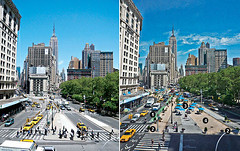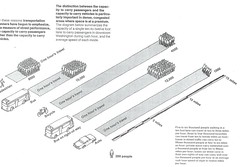New York Magazine article about NYC DOT Commissioner Janette Sadik-Khan

LEFT: Before; RIGHT: A New Madison Square. Last summer, the Department of Transportation remapped Broadway above 23rd Street. Downtown traffic that used to cross Fifth Avenue now merges with it on the west side of the street.1. A dedicated bike lane runs to the east of three lanes of Fifth Avenue.2. Three lanes of traffic were converted ot 41,700 square feet of public space.3. Café tables are maintained by the Flatiron/23rd Street Partnership.4. The discontinued sections of Broadway and Fifth Avenue were painted over with an epoxied gravel surface. (Photo: Courtesy of the New York City Department of Transportation)
"Honk, Honk, Aaah" is interesting in part because of the comments appended by readers. Many are quite interesting, such as asking why is biking called elitist when it is cheap enough for anyone to partake? Another negative comment asks a reasonable question from a mobility standpoint, about taking away for new bike lanes, hundreds of parking spaces in outer borough areas where bicycling isn't prevalent, but response comments are interesting, etc.
The article is about the idea of complete streets, about reorienting urban transportation policies and practices back towards pedestrians, transit and bicycling, and away from automobiles.
It offers some guidance to DC about action. Here, the car is still supreme, especially in terms of neighborhood resident concerns as expressed at public meetings, and in City Council deliberations, etc.
At the aforementioned conferences on Thursday, DC's planning director, Harriet Tregoning, spoke at both, including the keynote at the Urban Nexus conference. (Notes in a later blog entry.)
In both presentations she keyed on a couple numbers and ideas around the fact that the more you spend on transportation, the less you can spend on other things, including housing and consumer purchases.
In DC, Ms. Tregoning said that the average transportation cost per household is $9,500, but it is almost double that in the suburbs, and that for each $10,000 of household spending you can leverage at least $100,000 of mortgage. (Note that depending on whether or not you rely on transit and get transit benefits from your employer, the amount can be significantly less than $9,500. I haven't figured it out, but our household spends easily less than $3,000/year on transportation, giving us more money to do other things.)
She said that DC sales tax revenue increased in the last half of 2008, while it declined in most other places, and she attributes this to their being a larger disposable income in DC households, because less money is spent on transportation per capita, when compared to national averages. (Note that this idea jibes with the findings of Newman and Kenworthy's studies of metropolitan regions around the world, where they find that the areas of highest income have the best transit systems.)
This aligns then with the point that I make that a great transit system is key to center city competitive advantage. But it's an advantage that has two dimensions.
First, you don't have to pay for a car.
Second, you can get around relatively quickly without needing a car. As the region continues to become more congested* (also see "Traffic Congestion Dips As Economy Plunges: Survey Finds Rush-Hour Highways Less Packed in Downturn" from the Post), not having to get around by relying on cars is another economic advantage. This places DC ahead of all the other jurisdictions in the region, including Arlington, because at the core of the city, DC has 29 subway stations, in about a 15 square mile area. (Of course this means that other areas of the city aren't as well connected, and this should be addressed.)
* Road congestion is a pretty simple issue. A car is about 15 feet long and usually has one or two passengers. A 60 foot long articulated long bus is equal to about 4 cars in terms of using on-road space, cbut carries 60 to 100 people. Of course, an underground subway train, not hindered at all by automobiles, can move up to 1,500 people every 90 seconds. In any case, cars are an inefficient use of precious on-street space in places with limited space.

Mobility efficiency. From the Central Washington (DC) Transportation and Civic Design Study, 1977, published by the National Endowment of the Arts.
Labels: bicycling, car culture and automobility, progressive urban political agenda, transit, transportation planning, urban design/placemaking, walking



0 Comments:
Post a Comment
<< Home